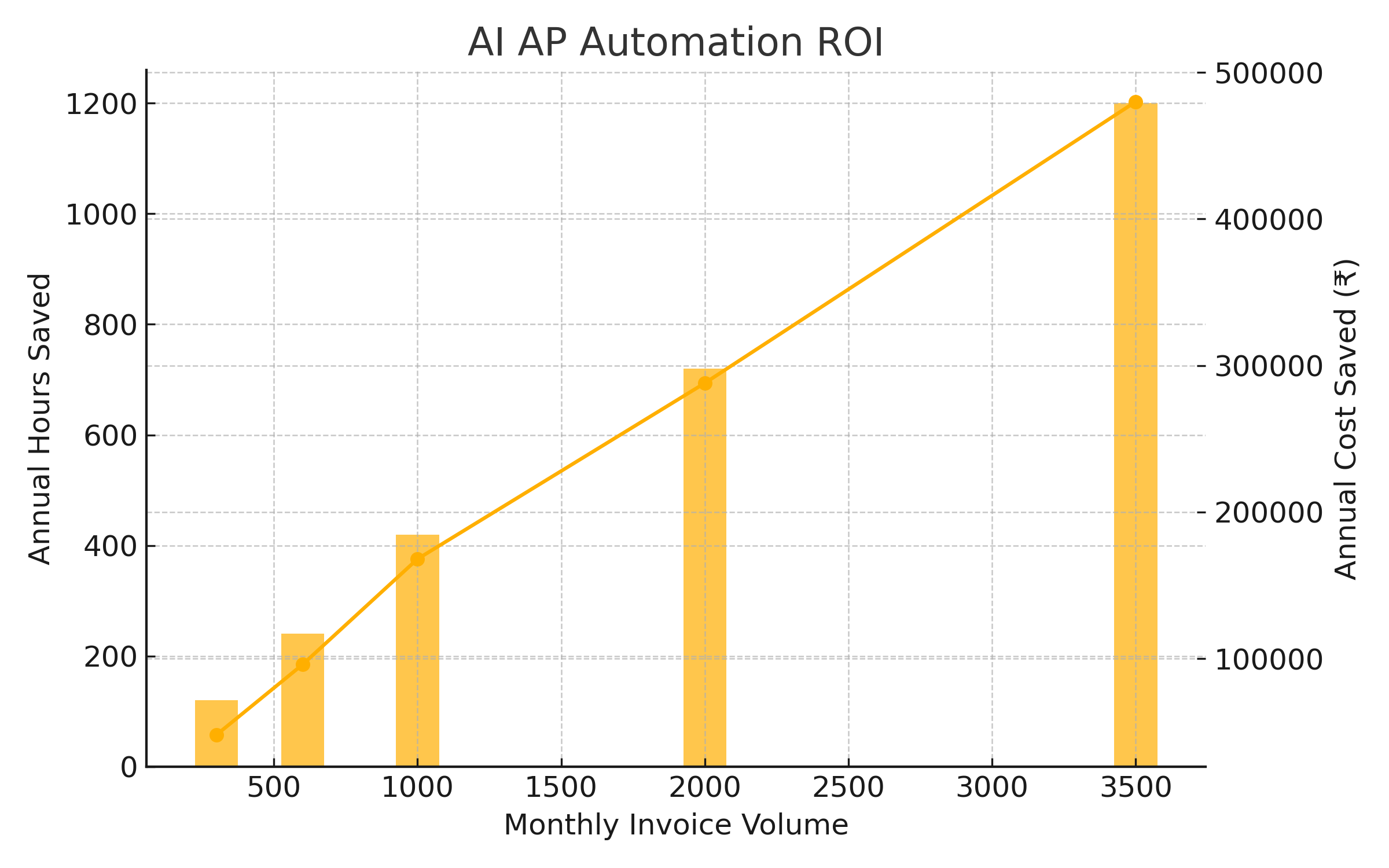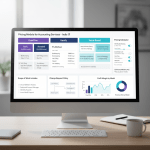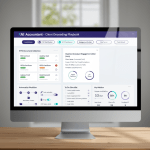Two Sides of the Same Invoice
Late on a Friday, Riya Shah, a finance head, locked her Ahmedabad office determined to clear a hundred invoices before the weekend. She never made it to dinner. A single GSTIN typo sent the stack back to the purchase department, restarting the approval chain. Eight kilometres away, Rahul Mehta, finance head at a growing logistics start-up, pressed one button on his dashboard and watched an entire week’s invoices push into Tally with clean GST codes and three-way matches already logged.
The only difference between their nights was software powered by artificial intelligence. Riya managed papers, email threads, and phone calls; Rahul managed exceptions flagged by an AI engine that had learned his company’s approval rules. Their stories illustrate the widening gap between traditional accounts payable desks and those that have embraced automation.
Recent data shows the gap is measurable. The average manual invoice in India costs between ₹800 and ₹1 300 when staff hours, errors, and late payment penalties are counted (Wise, gotbilled.com). Automated workflows bring that figure down to between ₹110 and ₹300, depending on volume, while cutting cycle times from a median of eleven days to fewer than three days (Concur, skalabletech.com). Yet a global survey released last month found that only seven percent of organizations actively use AI inside their payables process, even though forty percent plan to adopt it within a year (Concur).
India sits right in the middle of that curve: curious leadership teams, mounting compliance pressure, and a massive base of Zoho Books and Tally users that need a smarter way to receive, validate, and pay supplier bills.
This guide tells the full story. We begin with the pain points that slow Indian payables, walk through the technology that removes them, map a step-by-step implementation plan, and close with an extended return-on-investment model grounded in local salaries, GST regulations, and supplier practices. Along the way you will meet real companies, see the code behind intelligent OCR, and learn how to champion change inside a sceptical finance department.
Why Indian Invoices Move Slowly
Paper persistence
Physical bills still dominate in manufacturing, wholesale, and many service sectors. Courier deliveries and in-person handoffs delay intake by up to three days before an invoice even reaches finance. Vendor relationships often depend on stamped hard copies, an entrenched habit that digital portals alone have not killed.
Multiple approval gates
A typical Indian workflow touches purchasing, store-in-charge, accounts, department head, and director. Each gate adds not just time but risk of data loss, because information jumps from paper to Excel to ERP screens and back to printouts. Human re-keying introduces duplicate invoices, wrong GST rates, and misaligned purchase order numbers.
GST complexity
Since 2019 every business crossing a modest turnover threshold must reconcile input tax credit through GSTR-2B. Any mismatch in vendor GSTIN, HSN code, or tax slab blocks credit claim and generates follow-up calls. Finance teams therefore re-validate every tax field manually, extending cycle time and frustrating vendors waiting for payment.
Regulation around MSME dues
The MSME Development Act prescribes thirty to forty-five day payment terms to small suppliers. Delays attract compound interest penalties at three times RBI’s bank rate. Manual environments struggle to track those statutory deadlines, triggering avoidable cost.
Opaque cash visibility
When invoices sit in departmental drawers or individual inboxes, treasury cannot see accurate payable commitments. Working-capital projections turn into guesswork, leading to either idle cash or overdraft usage.
Together these frictions create a loop. Delays invite penalties, which tighten margins and starve investment in better systems, creating more delays.
Technology That Breaks the Loop
Artificial intelligence does not magically erase approvals or compliance, but it absorbs the repetitive parts, surfacing only the exceptions that need human judgement. Below are the core components you will find in modern Indian AP suites.
Intelligent OCR that speaks GST
Traditional OCR relied on fixed templates. New engines combine computer vision with language models to parse any invoice layout, detect fields by context, and output structured JSON ready for posting. Accuracy now exceeds ninety-eight percent on clear scans. AI Accountant and other start-ups train on millions of Indian invoices so they recognise NIC codes, transport details, and state-level tax splits out of the box.
Self-learning validation
Once data lands in the queue, machine learning compares it with purchase orders and goods receipt notes, calculating two-way or three-way match scores. When a field mismatches often, the model uses feedback to improve. One Mumbai e-commerce company using AI Accountant saw match rates jump from fifty-six percent to ninety-two percent after three months of feedback loops.
Dynamic approval routing
Instead of hard coded rules like “Director must approve every invoice over ₹50 000,” AI analyses past behaviour and risk indicators. If ten identical telecom bills have always been approved by the finance manager without issue, the eleventh may skip up the chain, reserving director time for exceptions such as new vendors or disputed quantities.
Continuous compliance monitoring
GST rules change twice a year. AI backed compliance modules pull updates from government notifications, adjust HSN validations, and flag invoices that would fail the upcoming GSTR-2B reconciliation. They also watch MSME due dates and push reminders before penalty windows open.
Real time ledger posting
AP automation only creates value when it talks to the ledger. Connectors push approved invoices straight into Tally or Zoho Books, attaching scanned originals and audit trails. This eliminates batch-entry Fridays and lets management dashboards reflect liabilities at the moment they arise.
Predictive cash planning
With a live stream of approved but unpaid invoices, treasury can run machine learning forecasts that consider vendor history, discounts, and seasonal spikes.
Market Landscape, India in 2025
The global AP automation market will reach USD 17.4 billion by 2031 at fourteen percent CAGR, and India is one of the fastest-growing slices of that pie (IndustryARC). Local vendors sit beside international giants, each racing to solve the uniquely Indian blend of GST, bilingual documents, and small supplier tech literacy.
- SAP Concur, Oracle Fusion, and NetSuite serve larger enterprises with India localisations.
- AI Accountant sits between, serving growing SMBs that live in Zoho Books or Tally and need AI without enterprise complexity.
Adoption drivers include rising cloud ERP penetration, government pressure toward e-invoicing, and the plain arithmetic of savings: automation lowers median invoice cost by up to eighty percent, depending on starting baseline (gotbilled.com). Barriers are staff resistance, fear of job loss, and concern over data privacy. We address each in the implementation roadmap that follows.
A Step by Step Roadmap for Finance Leaders
Step one, Capture every invoice at the door
Announce that the accounts office will no longer accept loose paper. Provide vendors with a single email address, set up a mobile scan kiosk for on-site deliveries, and digitise legacy papers. Intelligent OCR can only work on images it receives.
Step two, Build a master data foundation
Cleanse supplier masters, standardize GSTIN formats, and map purchase order fields to avoid false mismatches. Automation magnifies both good and bad data quality, so invest in a two week clean-up sprint before go live.
Step three, Configure and train the model
Most tools like AI accountant allow drag-and-drop field mapping, but the magic arrives when you feed historical invoices. Upload six to twelve months of data so the system learns common GL codes and approval patterns. Then run a pilot with one business unit for forty five days.
Step four, Design approvals with intent
Gather directors and department heads to agree risk thresholds. Frame the conversation around value, not control. For example: “You will see only ten percent of invoices, but they will represent eighty percent of fraud risk.” Balanced delegation builds trust in the AI recommendations.
Step five, Integrate with the ledger and bank
Use standard connectors for Zoho Books or Tally. Postings should carry scanned documents, validation log, and GST breakup so auditors trace back without separate files. If you run a bank payment portal like ICICI Connect, link pay-run batches directly from the AP engine.
Step six, Launch change management
Host supplier webinars explaining the new email channel and payment predictability. Inside the company, celebrate early wins. When the first month closes with two days saved, publish the number on the office notice board to convert sceptics.
Step seven, Measure and iterate
Track first-pass match rate, exception rate, average cycle time, cost per invoice, and percentage of GST credit claimed. Review exceptions monthly, tagging whether they stem from vendor mistakes, master data gaps, or model limits. That feedback keeps accuracy climbing.
Stories From the Front Line
Case study, Riya’s packaging company
Before automation: 6500 invoices per year, eleven day average cycle, ₹920 cost per invoice, eighty four late payment notices annually.
After six months on AI Accountant: three and a half day average cycle, ₹250 cost per invoice, zero late notices, supplier on time discount uptake rising from zero to twelve percent of invoices.
Case study, Delhi heavy equipment supplier
This firm handles high value, low volume invoices with complex GST and TDS splits. They built a custom rule in the AI engine that sends anything over ₹5 lakh straight to the CFO but lets line managers clear smaller routine bills. The result was a seventy percent reduction in director touches and a fourfold improvement in audit readiness.
Lessons learned
Both firms emphasised data clean-up as the single biggest success factor. They also noted that staff morale improved because junior accountants spent less time typing and more time analysing cash trends.
Regulatory Alignment
GST e-invoicing
The mandatory threshold dropped to ten crore turnover in 2023 and will slide further, covering nearly all GST registered entities by 2026 (ClearTax). Automation tools already embed IRN generation and real time invoice registration, sparing finance teams midnight logins to the government portal.
MSME payment rules
The Finance Act 2024 tightened deduction rules, disallowing expenses related to late payments. AI driven deadline tracking helps avoid disallowance.
TDS and TCS
New TDS sections on purchase of goods require dynamic application of thresholds. Machine learning modules apply the correct rate based on supplier volume to date, eliminating end of year surprises.
Audit trails
Revised Companies Act rules ask for complete digital audit logs. Automated AP solutions store every field level edit with user ID and time stamp, which satisfies auditors without extra paperwork.
The Numbers, Return on Investment
Below is a model for a mid-market company paying an accountant salary of ₹35 000 per month. The table assumes 12 months, 250 working days, and an eight hour day.
With discount capture and penalty avoidance, real savings often run thirty percent above these baseline figures.

Future Proofing Your Payables
Generative AI is moving beyond extraction into narrative analytics. Soon your AP engine will explain, in plain language, why courier invoices spiked last quarter or predict which vendor will breach payment terms next month.
Voice capture from WhatsApp audio bills is already in beta among Indian agritech start-ups. Blockchain based e-invoicing pilots promise tamper-proof authenticity, and CBDC integration could settle approved invoices instantly. Selecting a platform with an open architecture keeps you ready for these shifts.
Conclusion, A Quiet Invitation to Change
Your vendors will not care which software you run. They care when they get paid. AI makes prompt payment possible without overworking your team or risking compliance. The longer you delay, the more competitive advantage you leave on the table for firms like Rahul’s.
AI Accountant reads Indian invoices, matches them to orders, and posts them into Zoho Books or Tally while you sip evening chai. The paper era is closing. The transition can start on Monday morning.




